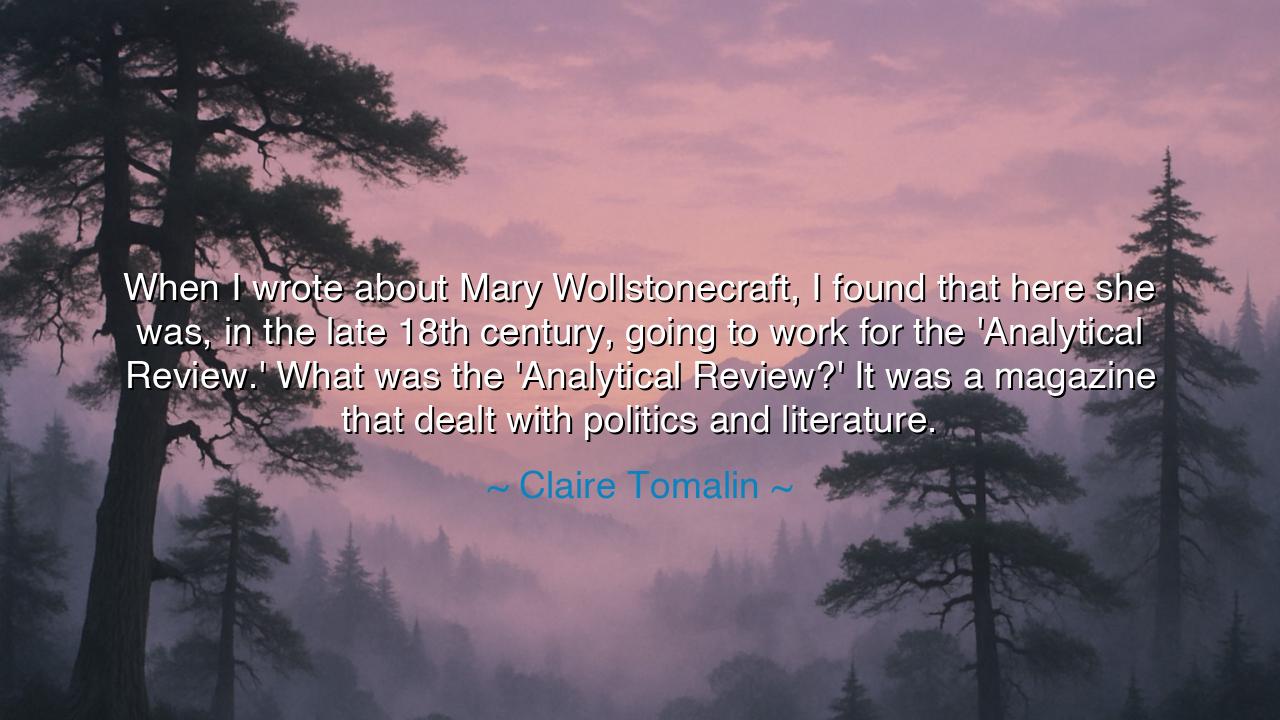
When I wrote about Mary Wollstonecraft, I found that here she
When I wrote about Mary Wollstonecraft, I found that here she was, in the late 18th century, going to work for the 'Analytical Review.' What was the 'Analytical Review?' It was a magazine that dealt with politics and literature.






The path of knowledge and courage is often walked by those who challenge the limits of their age. When Claire Tomalin reflected, “When I wrote about Mary Wollstonecraft, I found that here she was, in the late 18th century, going to work for the 'Analytical Review.' What was the 'Analytical Review?' It was a magazine that dealt with politics and literature,” she brought to light a moment of quiet heroism. In an era when women were seldom allowed a voice in public affairs, Mary Wollstonecraft stepped boldly into the world of ideas, wielding her pen as a sword against ignorance and oppression.
The Analytical Review was no ordinary publication. In the late 18th century, it served as a platform where politics and literature intertwined, shaping the minds of readers during a time of great upheaval. Revolutions stirred in America and France, and the old orders of monarchy and tradition trembled. To write for such a journal was not merely an act of employment, but an act of engagement with history, for the written word carried the power to influence nations and challenge kings. For Wollstonecraft, it was a stage upon which she could bring forth her radical vision of equality and reason.
Mary Wollstonecraft herself was a figure of extraordinary boldness. She rose from humble origins, determined to live by her intellect and principles. Through her work at the Analytical Review, she critiqued books and ideas, sharpening her voice and preparing the way for her later masterpiece, A Vindication of the Rights of Woman. In an age when women were expected to remain silent, her very presence in the halls of literary criticism was an act of defiance. Her courage reminds us that progress is often built upon the willingness of a few to dare greatly.
This story echoes through the corridors of history. Just as Wollstonecraft used the written word to challenge her world, others have done the same. Voltaire in France, Thomas Paine in America, and countless journalists and thinkers across time have wielded their pens to awaken societies. Their work reminds us that literature and politics are deeply intertwined, for stories shape beliefs, and beliefs shape the destiny of nations. The Analytical Review was one such forge, crafting ideas that would ripple outward into revolutions and reforms.
Tomalin’s reflection also speaks to the power of discovery. When we study the lives of the great figures of the past, we uncover not only their deeds but the worlds they inhabited. The realization that Wollstonecraft worked for a publication that bridged art and politics gives us a glimpse of her growth and the forces that shaped her voice. It teaches us that greatness is not born in isolation, but in dialogue with the ideas and struggles of one’s time.
Let this wisdom endure: the written word is both shield and spear. Through it, those who are silenced can speak, and those who are oppressed can rise. Mary Wollstonecraft’s journey through the Analytical Review was not merely the story of a woman finding her place, but the story of a revolution of thought, proving that literature and politics are forever bound in the struggle for freedom and truth.






UGUser Google
Craft question: how did regular criticism shape her later prose? Summarizing complex works, arguing in tight columns, and addressing readers across class lines sounds like an intensive rhetoric school. Could you outline specific skills honed there—framing stakes in a first paragraph, quoting fairly while repositioning claims, and closing with actionable implications? I’d love a training exercise inspired by that practice: pick one contemporary book, write a 600-word review that links it to a live civic question, and score it for clarity, charity, and consequence.
TTVu Thuy Tien
The archival trail matters. Periodicals mutate through reprints, abridgments, and partisan anthologies that tilt memory. When we cite her contributions, how do we verify text integrity and editorial context? I’d appreciate a practical protocol: compare multiple editions, locate printers’ marks, check errata, and triangulate with private letters. Also, note what’s missing—issues lost to fire, pieces unattributed, marginalia stripped in binding. How should historians responsibly label uncertainty so we neither undersell her voice nor overclaim evidence?
NANguyen Nguyen An
There’s also risk. Entering public discourse as a woman then carried social penalties and professional fragility. How did she calibrate tone, sources, and courage to remain legible to skeptical readers without diluting convictions? I’m looking for a taxonomy of hazards—libel laws, patron withdrawal, reputation slander—and the counter-moves available: solidarity networks, careful citation, strategic anonymity. Could you sketch case studies where she or peers were attacked and how they recovered? It would help gauge the bravery embedded in seemingly routine assignments.
SSinh
The pairing of literature with public affairs fascinates me. Today we silo essays into “culture” and “politics,” but that era read novels as arguments about society. What do we gain—or lose—when criticism refuses to separate imagination from governance? I’d love a reading path that models the braid: one novel, one political tract, and a period review that connects them. Then a prompt for writing our own hybrid piece, testing whether moral insight from narrative can sharpen rather than blur civic judgment.
HGHoang Giang
I’m curious about the newsroom realities behind that appointment. What did editorial labor look like for a woman at an 18th-century review? Pay rates, pseudonyms, deadlines, correspondence with publishers—were there gatekeepers she had to charm or outmaneuver? If surviving letters or ledger entries exist, could you point to the most revealing ones? I’d like a reconstruction of workflow: manuscript arrives, initial summary, political angle identified, final copy revised to fit house style. Understanding those constraints might clarify both courage and craft.